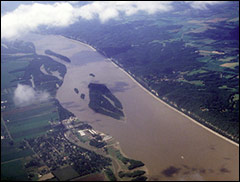There are 8 million stories in the Mississippi Basin, and this week we’ve told only a few. As lead editor of this Army Corps series, I’ve been immersed for the last few months in all things Mississippi River. Coming out the other side, I have a few answers, yes, but even more questions to explore. Below is my personal working list of issues that — while perhaps less acknowledged nationally than the spectacular disaster that is New Orleans and the Louisiana coast — rank high in determining a bright or dim future for the Mississippi Basin’s communities, both human and wild.

It makes one hell of a neighbor.
Photo: nasa.gov
1. Living with Risk
In New York City, most of us have installed bars across our windows and double locks on our doors. New Yorkers tend not to forget that living here, there’s a relatively high risk someone will try to break into our homes and steal our stuff — and no one tells us otherwise. We’re not special, of course: many Californians live with the ever-present risk of earthquakes, and design buildings to increase the chances they’ll survive the next one. In other parts of the West, officials urge homeowners to build, landscape, and maintain properties in ways that will help protect them from wildland fires.
But it’s different for people living and working behind the levees of greater St. Louis, of New Orleans, and of other flood-prone spots on the Mississippi. They have been assured for generations that they are safe — and much of the time, that’s true. In many locations, they are not expected to build differently to account for the (arguably) rare one-in-a-hundred flood. However, it’s the exceptions — violent, life-altering exceptions — that prove the inherent risks of setting up life behind a levee.
Isn’t it time for residents and their representatives to change their ways to account for these periodic, and largely predictable, weather events? In some places, that’s happening. When residents of Biloxi, Miss., climb the stairs of rebuilt homes set on nine-foot pilings above the ground, they likely won’t forget that they’re living in the path of future Hurricane Katrinas.
2. Who’s Mitigating Whom?
Should the same federal agency — the Army Corps of Engineers — be responsible for not only planning and building Mississippi Basin flood protections, but assessing how much environmental damage those projects will cause, fixing up that damage, and reporting back to Congress on how well all that went? And all from the same budget? “The Corps’ goal is to actually build projects,” says Melissa Samet of American Rivers. “If you highlight the fact that there are big environmental impacts, that usually hurts that effort. The cost of mitigation is a project cost, so it adds to the cost of the project. And then there’s this whole other layer of getting it implemented, getting it monitored, getting it done, that the Corps has historically had problems with.” Conflict of interest-o-rama!
3. Zebra Musseling In
Invasive species — a known and serious problem in the Great Lakes — have also worked their way into the Mississippi Basin, where they are posing dangerous threats to native species and ecologies. Asian carp are pushing native buffalo carp out of the Illinois River. Retiring Higgins’ Eye mussels on the Upper Mississippi — already hurt by ecological changes brought on by the lock-and-dam system — are being ousted by resource-hogging non-native zebra mussels, which alter the quality of the water and the riverbed for the worse in the process.
The Mississippi River has been so thoroughly engineered over the past two centuries — and those changes so vociferously defended in the name of perpetuating the nation’s economic growth — that without deeper reflection, it would be tempting to call it a loss as far as “wild nature” is concerned. But the native ecological qualities and processes of the Mississippi and its wildlife — its “ecosystem services” — likely have at least as much value as the goods on the barges traversing the locks and dams. Who’s quantifying that value, and what’s the cost to us if it becomes impossible to recover? And hey — what responsibilities do we have to the well being of other species, even if they don’t rate directly on our profit and loss statements? The Mississippi’s going to be a proving ground for that debate in coming decades.
4. It’s Not Easy Being Amphibian
The likelihood that climate change will bring more moisture to the mid-Mississippi River region might sound like a boon for amphibians and fish. But the way that rain is likely to fall — in less frequent but heavier bursts — could mean disaster for aquatic species dependent upon more even water flows. “If you’re getting very intense episodes of precipitation, it means in other parts of the year you’re getting intense drying episodes,” says St. Louis University biologist Jason Knouft. “And the majority of aquatic diversity occurs in smaller streams, say across the entire Mississippi Basin,” that are more susceptible to drying out. “You’re altering these flow regimes,” Knouft says, “which then has cascading effects on the habitat quality for aquatic taxa, and it sort of cascades down.” Who speaks for the climate-challenged fishes?
5. Ruler of All the River
In a 2007 report on Mississippi River water quality, the National Academy of Sciences opined that, “Too little coordination among the 10 states along the river has left the Mississippi River an ‘orphan’ from a water quality monitoring and assessment perspective. Stronger leadership from the U.S. Environmental Protection Agency, along with better interstate coordination, is needed to address these problems.”
And why stop at water quality? There are plenty of cross-border crises to choose from: Higher flood levels, threats to local and national economies if New Orleans washes away, climate change impacts, native species protection, disintegrating stormwater systems, sewer overflows, etc. And then there’s the hypoxic “dead zone” radiating from the mouth of the Mississippi River into the Gulf of Mexico — created in large part by runoff from agricultural operations throughout the basin.
Kudos are due to the growing collaborations along the Mississippi corridor that are working to protect the river, such as those that Grist’s Sarah van Schagen noted in her account from Dubuque, Iowa, last fall; the organizers of and participants in February’s Levee Safety Summit in St. Louis; and the environmental groups behind the Corps Reform Network. They’re pointing the way to the future. More is needed.
6. Everything’s Rhine
The Army Corps dredges, diverts, locks, dams, dikes, and channelizes the Mississippi and its tributaries largely in the name of facilitating navigation — remember, it was the federal government’s right to regulate commerce that led Congress to set the Corps loose on the river back in the 1820s.
But commerce can coexist with a Mississippi River that’s also being managed for higher ecological values, flood safety, and the onset of climate change. Southern Illinois University geologist Nicholas Pinter, who has studied rising flood levels on the Missouri and Mississippi rivers, points to cross-border initiatives in Europe that are aiming to decrease damage from river flooding by maintaining low usage of the floodplains, and removing navigational structures that impede flowing water and raise flood levels. “It’s not even a question for them of increasing development in the floodplain,” says Pinter.
In low-lying Holland, this “Room for the River” policy has included lowering dozens of dikes along the Rhine and Meuse rivers; they’ll be overtopped in floods and thus relieve pressure on dikes further downriver. “It’s very clear in the literature over there that this was driven by late 20th century climate change,” says Pinter. “The Dutch government saw increasing amounts of water coming down the river. The consequences of doing nothing would have been horrific.”
Barge traffic on the Rhine is managed with significantly less intrusive engineering, he says, using single-hulled barges with a maximum draft of four to five feet — whereas the double-hulled barges on the Mississippi draft twice as much, and sometimes move in huge rafts of 40 or more. “Navigation could continue completely but perhaps differently” on the Mississippi, says Pinter, “with a new strategy for engineering the river.”
—-
There are many, many smart, creative minds set on solving the problems of the Mississippi and its communities — but also a legacy stretching back two centuries of powerful but shortsighted, self-interested river management to overcome. In the case of the Army Corps of Engineers, I wonder if this transformation will have to arise from changes within — as much as pressure from without — to really ensure a bright future for the Mississippi River.
I don’t have a prescription in my pocket for how that will happen — but I am looking forward to covering it.




